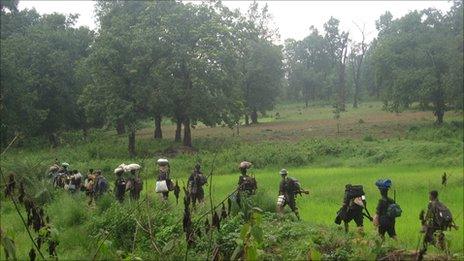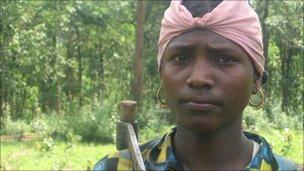Life in an Indian Maoist jungle camp
- Published
Watch: Daily life inside a Maoist forest hideout in India
Thousands of people have been killed in the bloody Maoist insurgency across swathes of central and eastern India. The BBC's Suvojit Bagchi, who was granted unprecedented access to a Maoist camp in the depths of the Chhattisgarh jungle, describes the rebels' precarious life.
After eight hours of walking in dense forest, in the early evening we entered a narrow, barren stretch of land hemmed in by hillocks.
At the far end stood a few blue and yellow tents.
Somji, one of the men who collected me between a small town in south Chhattisgarh and the thick central Indian forest, picked up speed as we approached.
A tall man standing guard with a rifle flung over his shoulder whistled and people started rushing towards us.
In under a minute, the camp members stood in formation and began singing a welcome song.
Each member in the queue raised their fist to whisper "lal salaam" - "red salute".
Mostly aged between 15 and 30 years old, the men and women in the camp wore rubber sandals, olive green battle fatigues and carried guns of various makes.
India's Maoist rebels say they are fighting for the rights of indigenous tribespeople and the rural poor. But the battle has been brutal: they frequently launch deadly attacks on India's security forces and those thought to support them.

Maoist rebels move around constantly to avoid detection by the security forces
In April 2010 Chhattisgarh was the site of the bloodiest Maoist attack yet on the security forces - 75 troops were killed. Paramilitary forces also launched attacks on tribal communities to restrict Maoist activities.
Camp security
Maoist platoons normally set up their camps in a semi-circle with one tent in the centre - the "headquarter".
Every time a camp is set up, the commander conducts a roll-call and updates camp members about their responsibilities if they come under attack.
Akash, 18, was in charge of my security at the first camp. He also gave me a few lessons in self defence.
He slept for about four hours each night: two hours were spent guarding the camp from under a mohua tree in drenching rain.
Nonetheless, he never failed to wake me up early for my walks through several kilometres of rain-sodden forest.
Though the purpose of these walks was to take me to villages and camps in the Maoist-controlled Dandakaranya forest, I learned the rebels walked long distances every few days for their own safety.
"If we stay in a place for long, chances are that information of our stay will get out and we will get encircled."
The constant movement, he told me, also helps them gather information about the whereabouts of security forces from villagers.
The relationship with villagers in areas they control is generally positive, but not always. Maoist will kill suspected informers and that has the potential to create a climate of fear. But they are also aware that harming ordinary villagers will simply erode their support base.
But this is a highly polarised area. In areas controlled by the paramilitary units there is little support for the Maoists - and villagers who display such sympathies have uncertain fates.
Camp routine
On days when we were not moving camp, I would rest on my makeshift bed of a plastic sheet, and watch the "comrade-soldiers" swinging their guns to instructions being shouted out by a platoon commander.

The rebels are active in swathes of central and eastern India
Ganita, 18 and a deft hand with a rifle, also gave me a detailed account of their daily chores.
Maoists participate in "community service", she said, such as helping elderly farmers, digging village wells and providing basic health care to locals.
This week Ganita was assigned to kitchen work.
Her kitchen was spread under one tent. Breakfast was limited to rice cooked with turmeric and ground nuts, while both lunch and dinner were just lentil soup and rice.
However, during my stay, frog, wild boar and monitor lizard meat were served a few times.
Evenings were dedicated to the study of party literature.
Published by the publicity wing of the Communist Party of India (Maoist), the writings highlighted party strategy and criticised the Indian state. They have about 12 magazines and the main one is published in the local tribal language, Gondi.
Each camp had one or two solar-powered car batteries that were used to power LED lamps that lit tents at night.
A couple of times each week, everybody assembled for a singing session in one of the plastic tents.
Local Gondi tunes were fused with revolutionary lyrics and hymns were sung to the memory of martyrs. The singing session would end with the BBC's Hindi news bulletin on the radio - its future is in doubt because of spending cuts.
"This is our only source of objective information," Maoist spokesperson in south Chhattisgarh, Gudsa Usendi, told me.
Films
When there were no sing-songs, films would be played on a laptop late into the night.

Many of the Gond tribal people have joined the Maoist movement
One film that was repeatedly screened was Do Bigha Zameen or Two Acres of Land, made in 1953 about the plight of a small farmer in Nehru's India.
Another popular film was The Axis of War which includes a depiction of Mao's long march.
Interestingly, Bruce Lee's Enter the Dragon is a roaring hit among the young cadres.
The guerrillas often invited locals to join their late-night soirees when they stayed near villages.
Most villagers had never seen a film before the Maoists showed them one.
"Families finish dinner early and come here to watch the late-night show whenever there is one," said one villager.
At the end of the day, I would lie down with up to a dozen guerrillas in one of the cramped tents.
As I drifted off to sleep, I couldn't help thinking how the peace of the night - despite the snoring of sleeping rebels and the buzzing of countless mosquitoes - belied the dangers that surrounded us.